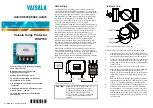
EN-22
Viewing computer images (continued)
D. Projecting images
Preparation:
• Remove the lens cap.
COMPUTER 1, 2 buttons
Main power switch
POWER indicator
LAMP 2 indicator
LAMP 1 indicator
DVI-D(HDCP)
button
ENTER button
,
,
,
buttons
POWER button
,
,
,
buttons
COMPUTER/DVI-D button
ENTER button
ZOOM/FOCUS button
LENS SHIFT button
POWER button
LENS SHIFT button
ZOOM/FOCUS button
1. Put the projector into standby mode by pressing the main power switch. The POWER indicator lights up red.
• If the projector was turned off before the lamp was cooled down suficiently last time, the fan may start rotating
and the POWER button may not work after the main power switch is turned ON. (The LAMP indicator blinks
green.) After the fan stops rotating, press the POWER button to turn back on the POWER indicator.
2. Turn on the power of the connected computer.
3. Press the POWER button.
• It may take about 2 minutes for the lamp to light up.
• The lamp fails to light up on rare occasions. In such a case, wait for a few minutes and then try again.
• Do not cover the lens with the lens cap while the lamp is on. Do not strip off the aluminium sheet inside the
lens cap.
• After the POWER button is pressed, the image may licker before the lamp becomes stable. This is not a
product malfunction.
• The lamp operation becomes stable in 1 minute after the power is turned on and then the lamp mode selected
in the menu is activated. During the activation, displayed images may be disturbed.
• The projector starts warming up when the POWER button is pressed. During the warm-up process, images
may appear dark and no commands are accepted.
• By blinking red, the LAMP indicator indicates that the lamp should be replaced soon. Replace the lamp when
the LAMP indicator blinks red. (See page 71.)
4. Press the ZOOM/FOCUS button to display the ZOOM/FOCUS menu.
5. Adjust with the
or
button to get a ine picture.
• When the ENTER button is pressed while the ZOOM/FOCUS menu is displayed, the adjustment mode is
switched between FAST and STEP. When FAST is selected, the speed of focus controlled by the
or
button
becomes fast, and it becomes slow when STEP is selected.
6. Select an input source.
• Press the COMPUTER/DVI-D button on the projector or the COMPUTER 1, COMPUTER 2 or DVI-D(HDCP)
button on the remote control that is corresponding to the terminal in use.
• The input source is switched from COMPUTER 1 to COMPUTER 2 to DVI at every press of the COMPUTER/
DVI-D button on the projector.
• The projector automatically selects the appropriate signal format. The selected signal format is displayed on
the screen.
• You cannot change the input source while the menu is being displayed.
• Though it may take some time before an image is displayed on the screen depending on the type of the input
signal, such symptom is not a malfunction.
• Images may not be projected in the correct position, depending on the type of the input signal. In such a case,
press the AUTO POSITION button. (See page 24.)
• When COMPUTER 1 or COMPUTER 2 is chosen as the source, images supplied from the computer may
flicker. Press the
or
button on the remote control to reduce flicker, if it occurs. (Fine adjustment)
7. Adjust the position of the projector to keep an appropriate projection distance with which images are projected in
their specified sizes.
8. Adjust the position of the projector so that the projector and the screen are perpendicular to each other. (See page 11.)
•
When the projector cannot be positioned perpendicularly to the screen, adjust the projection angle. (See page 14.)
















































